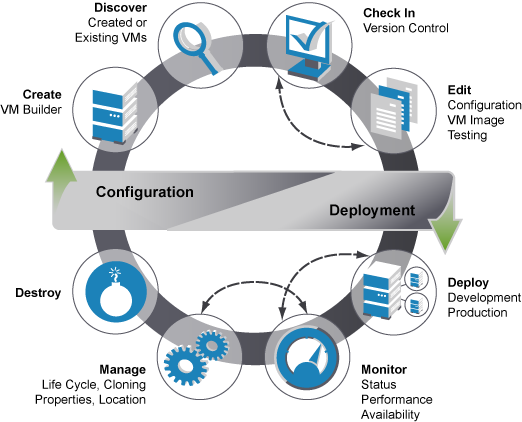1.2 The Virtual Machine Life Cycle
Automating the management of VMs through all aspects of the VM life cycle provides the ability to use your physical resources in the most efficient and productive manner. You create VMs as needed, put them under version control, provision them as jobs require, and remove them from the system when they are no longer needed.
Figure 1-2 The VM Life Cycle

The VM life cycle is divided into two parts: configuration and deployment. Configuration is performed on a VM in the security of a development environment which allows for creation, testing, and modification of the VM until you are ready to launch the VM into the production environment. Deployment performed in the production environment and the changes take place in real time. As the administrator, you might do both the configurations and deployments.
1.2.1 Configuring Virtual Machines
Configuring VMs includes creating, storing, editing, and versioning. These configurations are done in an environment removed from your production environment. These VMs do not affect your data center operations. The configurations are done to prepare the VM for data center launch. Any changes made after data center launch are done during the deployment phase of the life cycle.
Create: ZENworks Virtual Machine Builder (VM Builder) is used to create new Xen* VMs. You simply define the parameters of the VM you need and the VM is automatically created to your specifications. For more information on the VM Builder, see Section 1.3.2, Virtual Machine Builder.
Discover:
The Orchestrator Server discovers VMs that exist in your enterprise. In order to be available as a resource for jobs, the VM must have the ZENworks Orchestrator Agent installed on it. These can be VMs you have just created or VMs that you have already been using in your enterprise. For information on discovering VMs and VM host machines in ZENworks Orchestrator, see Section 1.3.5, ZENworks Orchestrator Console Elements. For information on installing the Orchestrator Agent on a VM, see Installing the Orchestrator Agent on VMs
in the Novell ZENworks Orchestrator 1.2 Installation and Getting Started Guide.
Check-in: Both created and discovered VMs can be checked into the ZENworks Virtual Machine Warehouse. When VMs are checked in, version control is implemented. You can decide to not check VMs in and these will not receive version control. For more information on the VM Warehouse, see Section 1.3.3, Virtual Machine Warehouse.
Edit: You check VMs out from the VM Warehouse to edit their configuration or operating system image. When you check the edited VM back into the VM Warehouse, the edited VM has its version number incremented. When you have two or more VMs, the designation of Gold Master version is used to identify the approved version. The Gold Master version is the version of the VM that launches when deployed by the Orchestrator Server. The Gold Master versions are also listed in the Orchestrator Console under the Repository and VM headings in the tree. For more information on editing VMs, see Section 4.5, Modifying a Virtual Machine after Checking In.
1.2.2 Deploying Virtual Machines
When deploying VMs, you designate management of the VMs that are under version control, tested, and ready for deployment. These include further developmental changes to the VM, changes made because of QA testing, or changes required after launching the VM into your data center’s production environment.
Deploy: Deployment operations are performed through ZENworks Orchestrator. When a VM is ready for your production environment, you can list either a started VM or a VM Template as a resource. These VMs, as stated before, must have the Orchestrator Agent installed on them before they become resources.
The ZENworks Orchestrator deploys a VM when it is needed to run a job just as it uses physical machines to meet the resource needs of a job. When a VM template is deployed, the template is cloned into a VM and then deployed. The cloned VM is destroyed when the job releases it. For information on deploying VMs, see Section 5.1, Deploying a Virtual Machine As a Resource.
Monitor: The ZENworks Monitoring Service, which is included as another perspective with VM Management, monitors every aspect of your VMs, including their performance, status, and availability. This service also monitors the host machines on which your VMs are deployed and can be extended to any physical machine in your network.
Manage: While your VMs are deployed you can manage any step of the life cycle of the VM according to your criteria. You can manage the process of cloning, overall properties of the VM, and you can use provisioning adapters to manage the location of the VM within your VM Host environment. You can also patch deployed VMs or send them to a directory for image editing. If a VM Host fails or experiences performance issues, the Orchestrator Server transfers the active, running VM to another server with barely a perceptible pause in the speed and continuity of the transfer of data. For more information on managing your VMs in runtime, see Section 5.3, Managing a Virtual Machine in Runtime.
Destroy: At the end of its usefulness, you can destroy the VM, which removes it from its listing in the ZENworks Orchestrator Console. To completely destroy the VM, you also need to delete its stored image in the VM Warehouse. For information on destroying VMs, see Section 5.4, Destroying a Virtual Machine